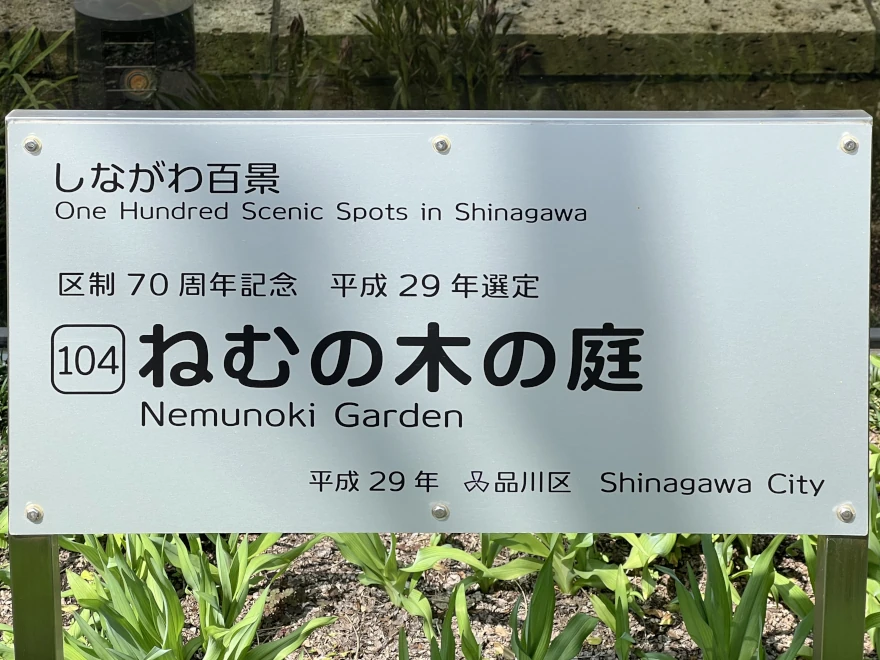Nemunoki Garden – A Quiet Floral Tribute to Empress Michiko
Nemunoki no Niwa, or “Garden of the Silk Tree,” is a quiet, beautiful space tucked away in Gotanda, Shinagawa Ward. Although the garden is small, it holds deep cultural meaning. It was built on part of the land where Empress Emerita Michiko spent her childhood, adding a heartfelt personal connection to its atmosphere.
Inspired by a Lullaby

photo: Siegfried Poepperl
The name of the garden comes from a poem Michiko wrote in her youth, called Nemunoki no Komoriuta (“Lullaby of the Silk Tree”). The soft rhythm of the poem reflects her love of nature and calm reflection. As a result, the garden feels like a living poem—gentle, simple, and full of quiet beauty.
Nemunoki Garden – Designed with Meaning
Opened in 2004, the garden was carefully planned to honor the legacy of Michiko’s family and her deep appreciation for the natural world. Despite its modest size, it contains about 50 kinds of plants and trees. In early summer, the silk tree blooms with soft pink flowers, while in spring and autumn, Princess Michiko roses add bright touches of orange.
A Place to Pause and Reflect
Alongside the greenery, the garden features stone paths and benches, encouraging visitors to sit, reflect, or simply enjoy the changing seasons. The space combines personal memory, imperial history, and quiet beauty in a way that feels both elegant and deeply peaceful.
A Hidden Gem in the City
Whether you enjoy poetry, Japanese history, or simply want a moment of calm, Nemunoki no Niwa offers a thoughtful escape. It leaves visitors with a gentle, lasting impression—one that connects the past and present through nature and emotion.
🧭 Visitor Information
Address: 5 Chome-19-5 Higashigotanda, Shinagawa City, Tokyo 141-0022
Best season: Early summer (for silk tree bloom); Spring and Autumn (for Princess Michiko roses)
Admission: Free
Shinagawa City Info: Nemunoki Garden
Note: No restrooms onsite. Please be respectful of the garden’s peaceful environment.
Where is it?
| what3words | ///holds.massing.hedge |
| latitude longitude | 35.6303128, 139.7199222 |
| Nearest station(s) | Gotanda Station (Yamanote, Asakusa and Ikegami lines) |
| Nearest public conveniences | Ikedayama Park, Gotanda Park or nearby convenience stores near Gotanda Station |
Show me a sign.

It’s in the garden. A small garden – you can’t miss it.
Withervee says…
This garden’s serenity feels surprisingly intimate for Tokyo. The link to Empress Michiko adds a layer of quiet gravitas—it’s less a park, more a poem in landscape form. But you may be thinking, Empress who?
Empress Emerita Michiko: A Symbol of Grace and Change
A Historic Marriage
Empress Emerita Michiko, born Michiko Shōda in 1934, made history as the first commoner to marry into Japan’s imperial family. Her marriage to Crown Prince Akihito in 1959 brought a new sense of openness and warmth to a monarchy that had often seemed distant.
A Modern and Compassionate Empress
From 1989 to 2019, Michiko served as Empress during Emperor Akihito’s reign. During this time, she became deeply respected for her elegance, intelligence, and kindness. Not only did she appear regularly in public, but she also supported many charities and showed a great love for poetry, music, and literature.
A Lifelong Presence in Tokyo
Although she was born and raised in Tokyo, Michiko spent most of her adult life within the Imperial Household. Today, she lives with her husband at the Takanawa residence. Even in retirement, she enjoys a peaceful life surrounded by books, nature, and the arts. Her former childhood home in Gotanda is now remembered through a public garden called Nemunoki no Niwa.
A Human Touch to Royal Tradition
Michiko’s marriage and public role helped modernize the image of the imperial family. By showing warmth and emotion, she helped many people feel more connected to the monarchy. Her care for others—such as comforting disaster survivors and raising her children herself—made her a symbol of humanity within a traditional role.
A Lasting Legacy
Through her gentle strength and thoughtful actions, Michiko reshaped how an empress could be seen. She remains a beloved figure in Japan and a quiet inspiration to people around the world.
Empress Michiko and Her Lullaby
Although she is no longer in the public spotlight daily, Empress Emerita Michiko remains an inspiring symbol of dignity and artistry. Visitors to Japan often encounter references to her through gardens, cultural sites, and music. One of the most touching windows into her inner world is her lullaby, Nemunoki no Komoriuta—a gentle poem she wrote in her youth that has been cherished across generations.
The piece captures a sense of maternal tenderness and delicate emotion. Its themes of nighttime calm, nature, and dreaming deeply resonate with the Japanese aesthetic of quiet beauty. Today, visitors can find the spirit of this lullaby reflected in the serene “Garden of the Silk Tree” in Shinagawa—where blooming roses and the soft canopy of the silk tree invite reflection.
Nemunoki no Komoriuta (Lullaby of the Silk Tree)
by Empress Emerita Michiko (English translation below)
Japanese:
ねんねん ころりよ
ねむの木の
ねむの葉 揺れて
また夢をみる
母の胸に
顔をうずめて
聞くは ゆるやかな
ねむの歌
English (Translation):
Sleep, gently sleep,
Beneath the silk tree’s shade—
Its leaves swaying softly
as dreams return again.
With your face nestled
against your mother’s breast,
You listen to the tender song
of the sleeping tree.
Site Character
- Lifestyle 生活 (Seikatsu): ✔️
- Historical Significance 歴史 (Rekishi): ✔️
- Atmosphere/Natural Features 風土 (Fūdo): ✔️
Who in their right mind would vote for this?
- Literary romantics
- Imperial family admirers
- Quiet souls
- Garden lovers
- Mindful walkers
Further reading
The Emperor Emeritus and Empress Emerita
While you’re there…
Stroll over to Ikedayama Park to continue your erm… I suppose, urban green oasis relay(?)

